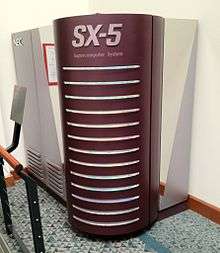NEC SX architecture

The SX series are vector supercomputers designed, manufactured, and marketed by NEC. There have been seven generations of SX systems since the first models, the SX-1 and SX-2, were announced in April 1983. Since the late 1990s, the SX series has been amongst the most advanced of vector supercomputers. The Earth Simulator, which is built from SX-6 nodes, was the fastest supercomputer from 2002 to 2004 on the LINPACK benchmark, achieving 35.86 TFLOPS. For his work on the SX series, Tadashi Watanabe received the Eckert–Mauchly Award in 1998 and the Seymour Cray Computer Engineering Award in 2006. Starting in 2001, Cray marketed the SX-5 and SX-6 exclusively in the US and non-exclusively elsewhere for a short time.
SX Series systems
Since the SX-4, SX series supercomputers are constructed in a doubly parallel manner. A number of central processing units (CPUs) are arranged into a parallel vector processing node. These nodes are then installed in a regular SMP arrangement.
| SX-2 | SX-3 | SX-4 | SX-5 | SX-6 | SX-7 | SX-8 | SX-8R | SX-9 | SX-ACE | |
|---|---|---|---|---|---|---|---|---|---|---|
| Max. CPUs | 1 | 4 | 32 | 16 | 8 | 32 | 8 | 8 | 16 | 1 |
| Peak CPU GFLOPS | 1.3 | 5.5 | 2 | 8 | 8 | 8.83 | 16 | 35.2 | 102.4 | 256 |
| Peak system GFLOPS | 1.3 | 22 | 64 | 128 | 64 | 282 | 128 | 281.6 | 1638 | 256 |
| Max. main memory | 256 MB | 2 GB | 16 GB | 128 GB | 64 GB | 256 GB | 128 GB | 256 GB | 1 TB | 1 TB |
| System memory B/W (GB/s) | 11 | 44 | 512 | 1,024 | 256 | 1,129 | 512 | 563.2 | 4,096 | 256 |
| Memory B/W per CPU (GB/s) | 11 | 22 | 16 | 64 | 32 | 35.3 | 64 | 70.4 | 256 | 256 |
| SX-4 | SX-4A | SX-5 | SX-6 | SX-8 | SX-8R | SX-9 | SX-ACE | |
|---|---|---|---|---|---|---|---|---|
| Max. nodes | 16 | 16 | 32 | 128 | 512 | 512 | 512 | 512 |
| Max. CPUs | 512 | 256 | 512 | 1,024 | 4,096 | 4,096 | 8,192 | 512 |
| Peak TFLOPS | 1 | 0.5 | 4 | 8 | 65 | 140.8 | 839 | 131 |
| Max. main memory | 256 GB | 512 GB | 4 TB | 8 TB | 64 TB | 128 TB | 512 TB | 32 TB |
| Total memory B/W (TB/s) | 8 | 4 | 32 | 32 | 131 | 281.6 | 2,048 | 131 |
Current system
The SX-ACE is the current model. Each SX-ACE CPU has a peak performance of 256 GFLOPS and can address up to 1 TB of memory. A single CPU makes up a node, and the system can scale to 512 nodes. [1]
Software environment
Most SX supercomputers run the SUPER-UX operating system (OS), and come with Fortran and C++ compilers. Cray has also developed an Ada compiler which is available as an option. Some vertical applications are available through NEC, but in general customers are expected to develop much of their own software.
The Earth Simulator uses a custom OS called "ESOS" (Earth Simulator Operating System). It has many features custom designed for the Earth Simulator which are not in the regular SUPER-UX OS.
In addition to commercial applications, there is a wide body of free software for the UNIX environment which can be compiled and run on SUPER-UX, such as Emacs, and Vim. A port of GCC is also available for the platform.
References
External links
| Records | ||
|---|---|---|
| Preceded by Fujitsu VP2600/10 4.0 gigaflops |
World's most powerful supercomputer (NEC SX-3/44) 1992 |
Succeeded by Thinking Machines CM-5/1024 59.7 gigaflops |